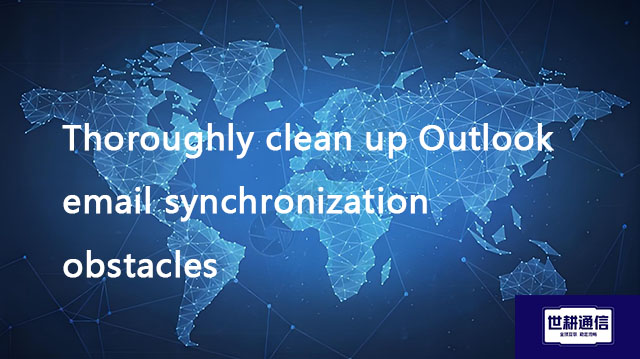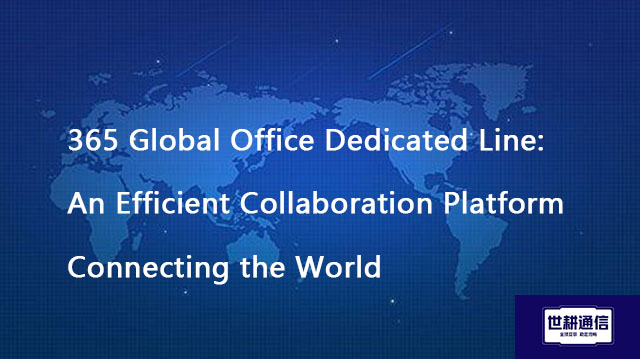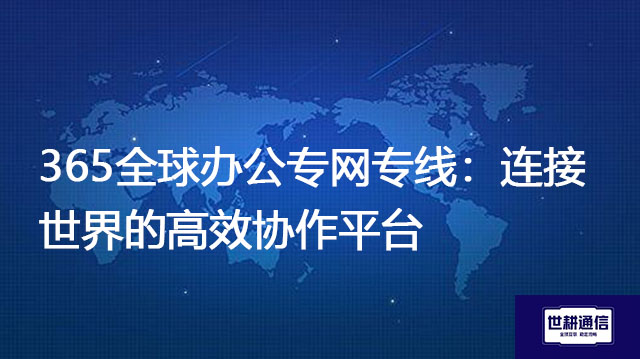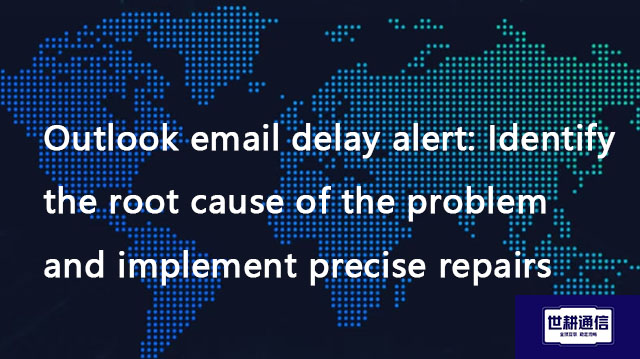Thoroughly clean up Outlook email synchronization obstacles??? Solution//Global IPLC service provider of Shigeng Communication
一、As the core tool of enterprise level email systems, Microsoft Outlook's synchronization function directly affects the daily communication efficiency of hundreds of millions of users. When emails cannot be synchronized properly, it not only leads to information lag, but also may cause serious business communication gaps. This article will systematically analyze the root causes of Outlook synchronization obstacles and provide a complete solution from basic to advanced to help you completely eliminate synchronization problems.
1. Deep analysis of the root cause of synchronous faults
Data file corruption: the core cause of synchronization failure
OST/PST file corruption: Offline data file (OST) or personal folder file (PST) corruption is a common cause of synchronization failure. When these files are structurally damaged due to abnormal closure, disk errors, or version conflicts, Outlook will not be able to properly record the synchronization status.
Cache inconsistency: When the local cache conflicts with the server data version (especially when using multiple devices or switching Outlook versions), Outlook will reject the synchronization operation and prompt an "item mismatch" error.
Network and server issues: invisible connectivity barriers
Connection configuration error: Outdated server address, incorrect port number (e.g. IMAP should be 993, SMTP should be 465/587), or mismatched encryption protocol (SSL/TLS vs STARTTLS) directly blocking communication.
Exchange server exception: Maintenance, migration, or policy changes to Exchange servers in an enterprise environment (such as incomplete mailbox move requests) can cause specific mailbox synchronization interruptions.
Configuration and rule conflicts: invisible traps set by humans
Add on interference: Third party plugins (especially security or CRM tools) may hijack the email processing flow and block normal synchronization channels.
Automatic rule out of control: Improper configuration of the 'resend undelivered emails' rule or incorrect labeling of old emails as tasks, resulting in historical emails being resent.
Synchronization frequency setting error: Regular sending/receiving is not enabled or the interval is too long (more than 30 minutes), resulting in email backlog.
Permission and system restrictions: environment enforced blockade
Security software interception: The email scanning function of antivirus software (such as Avast's "email protection") may misjudge the Outlook process as a threat.
Missing mobile permissions: Android/iOS devices have not granted Outlook contact/calendar permissions or disabled background refresh function.
Enterprise policy restrictions: Email size restrictions set by administrators, API blocking, or conflicting folder access permissions are missing.
2. Systematic troubleshooting solution
Phase 1: Basic repair (10 minute quick check)
Restart and network check
Completely close Outlook (confirm process termination through Task Manager) and restart the computer
Test network connectivity: ping outlook.office.com or accessing web email to verify network connectivity
Account setting verification
Server address (IMAP/POP3/SMTP)
Port number and encryption type
Login credentials (especially updated after password change)
Go to File>Account Settings>Server Settings, check:
Use the test account settings function to automatically diagnose connection issues
Clear lightweight cache
Mobile: Android Settings>Apps>Outlook>Storage>Clear Cache [i citation: 5]
Desktop: File>Options>Advanced>Send/Receive>Clear Offline Items
Phase 2: Intermediate Repair (File and Configuration Reconstruction)
OST/PST file repair
Locate SCANPST.EXE (path example: C: \ Program Files \ Microsoft Office \ root \ Office16)
Scan and repair damaged files (be sure to check the backup before repair)
3. Guidelines for Handling Special Scenarios
Mobile synchronization exception
Permission configuration:
IOS: Settings>Outlook>Enable Address Book/Calendar Permissions
Android: Settings>Apps>Outlook>Permissions>Allow contacts/calendar [i citation: 5]
Power saving mode conflict: Turn off low battery mode (iOS) or cancel Outlook's battery optimization (Android)
Calendar/contact synchronization failed
Calendar Conflict Resolution:
Right click on the calendar folder>Properties>Clear Offline Items
Manually check for conflicts: Folder list>Synchronization issues>Conflicts (permission required)
Contact Sync Switch: Outlook Mobile>Settings>Account>Enable 'Sync Contacts'
Abnormal resend of historical emails
Root cause cure steps:
Delete cache: Win+R>Run olk.exe -- devtools>Apply tags>Clear local storage
Reset sending mechanism: ` Send/Receive>Define Group>Uncheck 'Get subscription folder unread count'
4. Synchronize health maintenance strategies
Regular maintenance system
Monthly execution: SCANPST scan+cache cleaning (% localappdata% \ Microsoft \ Outlook \ RoamCache)
Large PST file splitting: Create new archive files when exceeding 20GB
Key points of environmental optimization
Network Security: Deploying QoS in Enterprise Environments to Ensure Exchange Traffic Priority
Client policy: Force enabling cached Exchange mode (registry key: HKCU \ Software \ Microsoft \ Office \ 16.0 \ Outlook \ cached Mode)
conclusion
Addressing Outlook synchronization issues requires systematic thinking: from file structure to network protocols, from local caching to server policies. Following the step-by-step troubleshooting process outlined in this article - from basic restart to advanced reconstruction - can solve over 95% of synchronization failures. For complex issues with persistent recurrence, it is recommended to conduct in-depth diagnosis by combining Windows Event Viewer (Event Viewer>Applications) with Outlook logs (/enablerlogging startup parameter). Keep the client updated and the environment clean to ensure smooth email synchronization.

二、Shigeng Communication Global Office Network Products:
The global office network product of Shigeng Communication is a high-quality product developed by the company for Chinese and foreign enterprise customers to access the application data transmission internet of overseas enterprises by making full use of its own network coverage and network management advantages.
Features of Global Application Network Products for Multinational Enterprises:
1. Quickly access global Internet cloud platform resources
2. Stable and low latency global cloud based video conferencing
3. Convenient and fast use of Internet resource sharing cloud platform (OA/ERP/cloud storage and other applications
Product tariff:
Global office network expenses | Monthly rent payment/yuan | Annual payment/yuan | Remarks |
Quality Package 1 | 1000 | 10800 | Free testing experience for 7 days |
Quality Package 2 | 1500 | 14400 | Free testing experience for 7 days |
Dedicated line package | 2400 | 19200 | Free testing experience for 7 days |







